By Fiona Copland and Sue Garton
Did you know that the introduction of languages into primary schools has been dubbed the world’s biggest development in education? And, of course, overwhelmingly, the language taught is English. Already the world’s most popular second language, the desire for English continues apace, at least in the short term, and with this desire has come a rapid decrease in the age at which early language learning (ELL) starts. From the kindergartens of South Korea to classes of 70+ in Tanzania, very young children are now being taught English. So is it a good idea to learn English from an early age? Many people believe that in terms of learning language, the younger the better. However, this notion is based on children learning in bilingual environments in which they get a great deal of input in two or more languages. Adults see children seemingly soaking up language and speaking in native-like accents and think that language learning for children is easy. However, most children do not learn English in this kind of bilingual environment. Instead, they learn in formal school settings where they are lucky if they get one or two hours of English tuition a week. In these contexts, there is little or no evidence that an early start benefits language learning. Indeed, it has been argued that the time spent teaching English is better spent on literacy, which has been shown to develop children’s language learning potential.
So why are children learning from so young an age? One answer is parent power. Parents see the value of English for getting ahead in the global world and put pressure on governments to ensure children receive language tuition from an early age. Another answer is inequality. Governments are aware that many parents pay for their children to have private tuition in English and they see this as disadvantaging children who come from poorer backgrounds. In an attempt to level the playing field, they introduce formal English language learning in primary schools. While this is admirable, research shows that school English is not generally effective, particularly in developing countries, and in fact tends to advantage those who are also having private lessons. Another argument for sticking to literacy teaching?

Of course, government policy eventually translates into classroom reality and in very many countries the introduction of English has been less than successful. One mammoth problem is the lack of qualified teachers. Contrary to popular belief, and despite representations in film and television programmes, being able to speak English does not equate to an ability to teach English, particularly to very young children. Yet in many places unqualified native English speaking teachers are drafted into schools to make good the shortfall in teacher provision. In other countries, local homeroom teachers take up the burden but may not have any English language skills or may have no training in language teaching. Other problems include a lack of resources, large classes and lack of motivation leading to poor discipline. Watch out Mr Gove — similar problems lie in store for England in September 2014! (When the new national curriculum for primary schools launches, maintained primary schools will have to teach languages to children, and yet preparation for the curriculum change has been woefully inadequate.)
Why should we be in interested in this area of English language teaching when most of it happens in countries far away from our own? David Graddol, our leading expert on the economy of English language teaching, suggests that the English language teaching industry directly contributes 1.3 billion pounds annually to the British economy and up to 10 billion pounds indirectly through English language education related activities. This sector is a huge beneficiary to the British economy, yet its importance is widely unacknowledged. For example, in terms of investigating English language teaching, it is extremely difficult in England to get substantial funding, particularly when the focus is on countries overseas.
From the perspective of academics interested in this topic, which we are, the general view that English language teaching is not a serious contender for research funding is galling. However, the research funding agencies are not alone. Academic journals rarely publish work on teaching English to young learners, which has become something of a Cinderella subject in research into English language teaching. There are numerous studies on adults learning English in journals of education and applied linguistics, but ELL is hardly represented. This might be because there is little empirical research or because the area is not considered important. Yet as we suggest, there are huge questions to be asked (and answered). For example, in what contexts are children advantaged and disadvantaged by learning English in primary schools? What are the most effective methods for teaching languages to children in particular contexts? What kind of training in teaching languages do primary teachers need and what should their level of English be? The list of questions, like the field, is growing and the answers would support both the UK English language industry and also our own approach to language learning in primary schools, where there is very little expertise.
ELT Journal is a quarterly publication for all those involved in English Language Teaching (ELT), whether as a second, additional, or foreign language, or as an international Lingua Franca. The journal links the everyday concerns of practitioners with insights gained from relevant academic disciplines such as applied linguistics, education, psychology, and sociology. A Special Issue of the ELT Journal, entitled “Teaching English to young learners” is available now. It showcases papers from around the world that address a number of key topics in ELL, including learning through online gaming, using heritage languages to teach English, and the metaphors children use to explain their language learning.
Fiona Copland is Senior Lecturer in TESOL in the School of Languages and Social Sciences at Aston University, Birmingham, UK, where she is Course Director of distance learning MSc programmes in TESOL. With colleagues at Aston, Sue Garton and Anne Burns, she carried out a global research project titled Investigating Global Practices in Teaching English to Young Learners which led to the production of a book of language learning activities called Crazy Animals and Other Activities for Teaching English to Young Learners. She is currently working on a project investigating native-speaker teacher projects. Sue Garton is a Senior Lecturer in TESOL and Director of Postgraduate Programmes in English at Aston University. She worked for many years as an English language teacher in Italy before joining Aston as a teacher educator on distance learning TESOL programmes. As well as leading the British Council funded project on investigating global practices in teaching English to young learners, she has also worked on two other British Council projects, one looking at the transition from primary to secondary school and the other, led by Fiona Copland, on investigating native-speaker teacher schemes. They are editors of the ELT Journal Special Issue on “Teaching English to young learners.“
Subscribe to the OUPblog via email or RSS.
Subscribe to only education articles on the OUPblog via email or RSS.
Subscribe to only language articles on the OUPblog via email or RSS.
Image: Student teacher in China by Rex Pe. CC-BY-2.0 via Wikimedia Commons.
The post Children learning English: an educational revolution appeared first on OUPblog.



